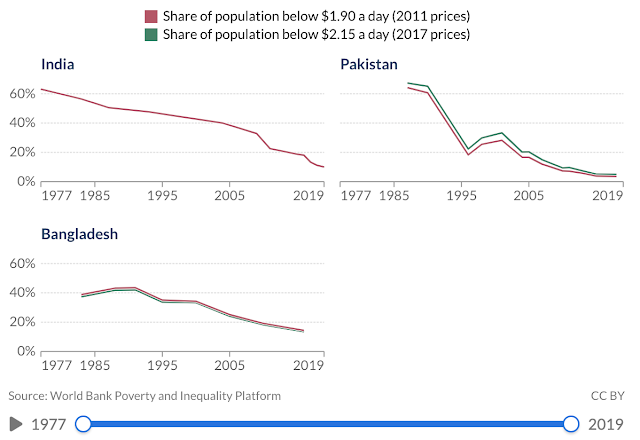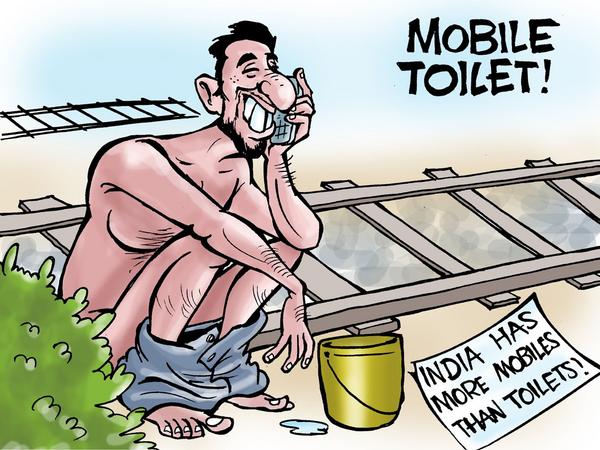At the $3.65 poverty line, India accounts for 40% of the slight upward revision of the global poverty rate from 23.6% to 24.1%, according to...

www.southasiainvestor.com
At the $3.65 poverty line, India accounts for 40% of the slight upward revision of the global poverty rate from 23.6% to 24.1%, according to the World Bank
September 2023 Global Poverty Update. It is the same update that made the following recent headline in the Indian and Pakistani media about Pakistan: "Pakistan's 40% Population Lives Below Poverty Line, Says World Bank". Fact: 45.9% of Indians and 39.4% of Pakistanis live below the $3.65 a day poverty line as of September, 2023, according to the the latest World Bank global poverty update that takes into account the impact of inflation on poverty rates. But neither the Pakistani media nor India's compliant "Godi Media" reported it. Nor did they question why poverty in India is growing despite Modi government's claim to be the "the world's fastest growing economy".
 |
| Global Child Poverty Rate. Source: UNICEF |
Another recent
report by UNICEF that went unnoticed by the media is that the child poverty rate in India far exceeds the rate in Bangladesh and Pakistan: At $2.15 poverty level, India has 11.5% children under poverty, Pakistan 5.6% and Bangladesh 5.1%. At $3.65 poverty level, India has 49.8% children under poverty, Pakistan 45% and Bangladesh 35.2%.
The
UNICEF data shows that South Asia region's child poverty rate at $2.15 for any year since 2013 drops to about a half when India is excluded.
The latest World Bank and UNICEF reports remind me of the famous Indian writer and poet
Javed Akhtar who told his audience at a conference in Mumbai earlier this year that he saw "no visible poverty" in Lahore during his multiple visits to Pakistan over the last three decades. Responding to Indian novelist Chetan Bhagat's query about Pakistan's economic crisis at ABP's "
Ideas of India Summit 2023" in Mumbai, Akhtar said: "Unlike what you see in Delhi and
Mumbai, I did not see any visible poverty in Lahore". This was Akhtar's first interview upon his return to India after attending "Faiz Festival" in Lahore, Pakistan.
 |
| Javed Akhtar at ABP Ideas Summit in Mumbai |
Chetan Bhagat began by talking about high inflation, low forex reserves and major economic crisis in Pakistan and followed it up by asking Javed Akhtar about its effects he saw on the people in Pakistan. In response, Akhtar said, "Bilkul Nahin (Not at all). In India you see poverty right in front of you, next door to a billionaire. Maybe it is kept back of the beyond. Only some people are allowed to enter certain areas. But you don't see it (poverty) on the streets. In India, it is right in front of you...amiri bhi or gharibi bhi (wealth and poverty). Sare kam apke samne hain (It's all in front of you). Wahan yeh dekhai nahin deta (you don't see it in Pakistan)".
 |
| Alhamra Arts Center, Lahore, Pakistan |
Disappointed by the response, Bhagat suggested that the Indian visitor could have been guided by his hosts through certain routes where he couldn't see any poverty. Javed Akhtar then said "it's not possible to hide poverty. I would have seen at least a "jhalak" (glimpse) of it as I always do in Delhi and Mumbai....I have been to Pakistan many times but I have not seen it".
What Javed Akhtar saw and reported recently is obviously anecdotal evidence. But it is also supported by
hard data. Over 75% of the world's poor deprived of basic living standards (nutrition, cooking fuel, sanitation and housing) live in India compared to 4.6% in Bangladesh and 4.1% in Pakistan, according to a recently released OPHI/UNDP report on multidimensional poverty. Here's what the report says: "More than 45.5 million poor people are deprived in only these four indicators (nutrition, cooking fuel, sanitation and housing). Of those people, 34.4 million live in India, 2.1 million in Bangladesh and 1.9 million in Pakistan—making this a predominantly South Asian profile".
The
UNDP poverty report shows that the income poverty (people living on $1.90 or less per day) in Pakistan is 3.6% while it is 22.5% in India and 14.3% in Bangladesh. In terms of the population vulnerable to multidimensional poverty, Pakistan (12.9%) does better than Bangladesh (18.2%) and India (18.7%) However, Pakistan fares worse than India and Bangladesh in multiple dimensions of poverty. The headline multidimensional poverty (MPI) figure for Pakistan (0.198) is worse than for Bangladesh (0.104) and India (0.069). This is primarily due to the
education and health deficits in Pakistan. Adults with fewer than 6 years of schooling are considered multidimensionally poor by OPHI/UNDP. Income poverty is
not included in the MPI calculations. The data used by OHP/UNDP for MPI calculation is from years 2017/18 for Pakistan and from years 2019/2021 for India.
The Indian government's reported multidimensional poverty rate of 25.01% is much higher than the OPHI/UNDP estimate of 16.4%.
NITI Ayog report released in November 2021 says: "India’s national MPI identifies 25.01 percent of the population as multidimensionally poor".
Earlier last year, Global Hunger Index 2022 reported that
India ranks 107th for hunger among 121 nations. The nation fares worse than all of its South Asian neighbors except for war-torn Afghanistan ranked 109, according to the
the report. Sri Lanka ranks 64, Nepal 81, Bangladesh 84 and Pakistan 99.
India and Pakistan have levels of hunger that are considered serious. Both have slipped on the hunger charts from 2021 when India was ranked 101 and Pakistan 92. Seventeen countries, including Bosnia, China, Kuwait, Turkey and UAE, are collectively ranked between 1 and 17 for having a score of less than five.
Here's a video of Javed Akhtar's interview with Chetan Bhagat at ABP's "Ideas of India Summit 2023". Please watch from 4:19 to 6:00 minutes.
ÐивÑÑÑÑÑ Ð²Ñдео, ÑлÑÑайÑе ÑлÑÐ±Ð»ÐµÐ½Ñ Ð¼ÑзикÑ, заванÑажÑйÑе оÑигÑналÑний конÑÐµÐ½Ñ Ñ Ð´ÑлÑÑÑÑÑ Ð²ÑÑм Ñим Ñз дÑÑзÑми, ÑÑм'ÑÑ Ð¹ ÑÑлим ÑвÑÑом на YouTube.

www.youtube.com
Related Links:
Haq's Musings
South Asia Investor Review
Pakistan Among World's Largest Food Producers
Pakistan Floods 2022
Food in Pakistan 2nd Cheapest in the World
India in Crisis: Unemployment and Hunger Persist After COVID
India Rising, Pakistan Collapsing
Record Number of Indians Seeking Asylum in US
Vast Majority of Pakistanis Support Imran Khan's Handling of Covid19 Crisis
Incomes of Poorest Pakistanis Growing Faster Than Their Richest Counterparts
Pakistanis Consuming More Calories, Fruits & Vegetables Per Capita
How Grim is Pakistan's Social Sector Progress?
Pakistan Fares Marginally Better Than India On Disease Burdens
COVID Lockdown Decimates India's Middle Class
Pakistan Child Health Indicators
Pakistan's Balance of Payments Crisis
How Has India Built Large Forex Reserves Despite Perennial Trade Deficits
Riaz Haq's Youtube Channel
PakAlumni Social Network
At the $3.65 poverty line, India accounts for 40% of the slight upward revision of the global poverty rate from 23.6% to 24.1%, according to...

www.southasiainvestor.com







 .
.











